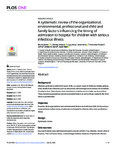A systematic review of the organizational, environmental, professional and child and family factors influencing the timing of admission to hospital for children with serious infectious illness
| dc.contributor.author | Carter, B | |
| dc.contributor.author | Roland, D | |
| dc.contributor.author | Bray, L | |
| dc.contributor.author | Harris, J | |
| dc.contributor.author | Pandey, P | |
| dc.contributor.author | Fox, J | |
| dc.contributor.author | Carrol, ED | |
| dc.contributor.author | Neill, Sarah | |
| dc.date.accessioned | 2020-09-16T15:33:46Z | |
| dc.date.issued | 2020-07-23 | |
| dc.identifier.issn | 1932-6203 | |
| dc.identifier.issn | 1932-6203 | |
| dc.identifier.other | ARTN e0236013 | |
| dc.identifier.uri | http://hdl.handle.net/10026.1/16370 | |
| dc.description.abstract |
BACKGROUND: Infection, particularly in the first 5 years of life, is a major cause of childhood deaths globally, many deaths from infections such as pneumonia and meningococcal disease are avoidable, if treated in time. Some factors that contribute to morbidity and mortality can be modified. These include organisational and environmental factors as well as those related to the child, family or professional. OBJECTIVE: Examine what organizational and environmental factors and individual child, family and professional factors affect timing of admission to hospital for children with a serious infectious illness. DESIGN: Systematic review. DATA SOURCES: Key search terms were identified and used to search CINAHL Plus, Medline, ASSIA, Web of Science, The Cochrane Library, Joanna Briggs Institute Database of Systematic Review. STUDY APPRAISAL METHODS: Primary research (e.g. quantitative, qualitative and mixed methods studies) and literature reviews (e.g., systematic, scoping and narrative) were included if participants included or were restricted to children under 5 years of age with serious infectious illnesses, included parents and/or first contact health care professionals in primary care, urgent and emergency care and where the research had been conducted in OECD high income countries. The Mixed Methods Appraisal Tool was used to review the methodological quality of the studies. MAIN FINDINGS: Thirty-six papers were selected for full text review; 12 studies fitted the inclusion criteria. Factors influencing the timing of admission to hospital included the variability in children's illness trajectories and pathways to hospital, parental recognition of symptoms and clinicians non-recognition of illness severity, parental help-seeking behaviour and clinician responses, access to services, use and non-use of 'gut feeling' by clinicians, and sub-optimal management within primary, secondary and tertiary services. CONCLUSIONS: The pathways taken by children with a serious infectious illness to hospital are complex and influenced by a variety of potentially modifiable individual, organisational, environmental and contextual factors. Supportive, accessible, respectful services that provide continuity, clear communication, advice and safety-netting are important as is improved training for clinicians and a mandate to attend to 'gut feeling'. IMPLICATIONS: Relatively simple interventions such as improved communication have the potential to improve the quality of care and reduce morbidity and mortality in children with a serious infectious illness. | |
| dc.format.extent | e0236013-e0236013 | |
| dc.format.medium | Electronic-eCollection | |
| dc.language | en | |
| dc.language.iso | en | |
| dc.publisher | Public Library of Science (PLoS) | |
| dc.subject | Child | |
| dc.subject | Communicable Diseases | |
| dc.subject | Databases, Factual | |
| dc.subject | Health Personnel | |
| dc.subject | Help-Seeking Behavior | |
| dc.subject | Hospitalization | |
| dc.subject | Humans | |
| dc.subject | Parents | |
| dc.subject | Severity of Illness Index | |
| dc.title | A systematic review of the organizational, environmental, professional and child and family factors influencing the timing of admission to hospital for children with serious infectious illness | |
| dc.type | journal-article | |
| dc.type | Journal Article | |
| dc.type | Research Support, Non-U.S. Gov't | |
| dc.type | Systematic Review | |
| plymouth.author-url | https://www.webofscience.com/api/gateway?GWVersion=2&SrcApp=PARTNER_APP&SrcAuth=LinksAMR&KeyUT=WOS:000575913700038&DestLinkType=FullRecord&DestApp=ALL_WOS&UsrCustomerID=11bb513d99f797142bcfeffcc58ea008 | |
| plymouth.issue | 7 | |
| plymouth.volume | 15 | |
| plymouth.publication-status | Published online | |
| plymouth.journal | PLOS ONE | |
| dc.identifier.doi | 10.1371/journal.pone.0236013 | |
| plymouth.organisational-group | /Plymouth | |
| plymouth.organisational-group | /Plymouth/Faculty of Health | |
| plymouth.organisational-group | /Plymouth/Faculty of Health/School of Nursing and Midwifery | |
| plymouth.organisational-group | /Plymouth/REF 2021 Researchers by UoA | |
| plymouth.organisational-group | /Plymouth/REF 2021 Researchers by UoA/UoA03 Allied Health Professions, Dentistry, Nursing and Pharmacy | |
| plymouth.organisational-group | /Plymouth/Research Groups | |
| plymouth.organisational-group | /Plymouth/Research Groups/Plymouth Institute of Health and Care Research (PIHR) | |
| plymouth.organisational-group | /Plymouth/Users by role | |
| plymouth.organisational-group | /Plymouth/Users by role/Academics | |
| dc.publisher.place | United States | |
| dcterms.dateAccepted | 2020-06-26 | |
| dc.rights.embargodate | 2020-9-18 | |
| dc.identifier.eissn | 1932-6203 | |
| dc.rights.embargoperiod | Not known | |
| rioxxterms.versionofrecord | 10.1371/journal.pone.0236013 | |
| rioxxterms.licenseref.uri | http://www.rioxx.net/licenses/all-rights-reserved | |
| rioxxterms.licenseref.startdate | 2020-07-23 | |
| rioxxterms.type | Journal Article/Review |


